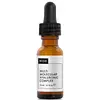What's inside
What's inside
 Key Ingredients
Key Ingredients

 Benefits
Benefits

 Concerns
Concerns

No concerns
 Ingredients Side-by-side
Ingredients Side-by-side

Water
Skin ConditioningGlycerin
HumectantHydrolyzed Yeast Extract
Skin ConditioningSodium Hyaluronate Crosspolymer
HumectantDimethyl Isosorbide
SolventPentylene Glycol
Skin ConditioningSodium Hyaluronate
HumectantHydrolyzed Sodium Hyaluronate
Skin ConditioningSodium Butyroyl Hyaluronate
HumectantPolyacrylate Crosspolymer-6
Emulsion StabilisingDisodium Acetyl Glucosamine Phosphate
Skin ConditioningBetaine
HumectantTrisodium Ethylenediamine Disuccinate
Yeast Extract
Skin ConditioningCetyl Hydroxyethylcellulose
Emulsion StabilisingTamarindus Indica Seed Gum
Emulsion StabilisingTremella Fuciformis Sporocarp Extract
AntioxidantLecithin
EmollientTetradecyl Aminobutyroylvalylaminobutyric Urea Trifluoroacetate
Skin ConditioningMyristoyl Nonapeptide-3
Skin ConditioningMagnesium Chloride
Sodium Benzoate
MaskingPotassium Sorbate
PreservativePPG-26-Buteth-26
Skin ConditioningPEG-40 Hydrogenated Castor Oil
EmulsifyingEthylhexylglycerin
Skin ConditioningChlorphenesin
AntimicrobialPhenoxyethanol
PreservativePolyglucuronic Acid
Skin ConditioningWater, Glycerin, Hydrolyzed Yeast Extract, Sodium Hyaluronate Crosspolymer, Dimethyl Isosorbide, Pentylene Glycol, Sodium Hyaluronate, Hydrolyzed Sodium Hyaluronate, Sodium Butyroyl Hyaluronate, Polyacrylate Crosspolymer-6, Disodium Acetyl Glucosamine Phosphate, Betaine, Trisodium Ethylenediamine Disuccinate, Yeast Extract, Cetyl Hydroxyethylcellulose, Tamarindus Indica Seed Gum, Tremella Fuciformis Sporocarp Extract, Lecithin, Tetradecyl Aminobutyroylvalylaminobutyric Urea Trifluoroacetate, Myristoyl Nonapeptide-3, Magnesium Chloride, Sodium Benzoate, Potassium Sorbate, PPG-26-Buteth-26, PEG-40 Hydrogenated Castor Oil, Ethylhexylglycerin, Chlorphenesin, Phenoxyethanol, Polyglucuronic Acid
Water
Skin ConditioningNiacinamide
SmoothingGlycerin
HumectantSodium Hyaluronate
HumectantAloe Barbadensis Leaf Juice
Skin ConditioningButylene Glycol
HumectantArbutin
AntioxidantAcetyl Hexapeptide-8
HumectantNonapeptide-1
Skin ConditioningPalmitoyl Tripeptide-1
Skin ConditioningPalmitoyl Tripeptide-7 Hcl
Skin ConditioningPalmitoyl Tripeptide-37
Skin ConditioningSh-Decapeptide-9
Skin ConditioningSh-Oligopeptide-1
Skin ConditioningRh-Polypeptide-45
Skin ConditioningSh-Polypeptide-16
Skin ProtectingSh-Polypeptide-22
Skin ConditioningThuja Orientalis Leaf Extract
AntioxidantZanthoxylum Schinifolium Leaf Extract
Skin ConditioningPolygonum Cuspidatum Root Extract
AntioxidantMalus Domestica Fruit Cell Culture Extract
Skin ConditioningVitis Vinifera Callus Culture Extract
1,2-Hexanediol
Skin ConditioningPhospholipids
Skin ConditioningAscorbyl Palmitate
AntioxidantRetinyl Palmitate
Skin ConditioningTocopheryl Acetate
AntioxidantPanthenol
Skin ConditioningDimethyl Sulfone
SolventSimmondsia Chinensis Seed Oil
EmollientPersea Gratissima Oil
Skin ConditioningArgania Spinosa Kernel Oil
EmollientEthylhexylglycerin
Skin ConditioningPropylene Glycol
HumectantMagnesium Ascorbyl Phosphate
AntioxidantAscorbic Acid
AntioxidantPolysorbate 20
EmulsifyingDextran
Carbomer
Emulsion StabilisingSodium Benzoate
MaskingPhenoxyethanol
PreservativeWater, Niacinamide, Glycerin, Sodium Hyaluronate, Aloe Barbadensis Leaf Juice, Butylene Glycol, Arbutin, Acetyl Hexapeptide-8, Nonapeptide-1, Palmitoyl Tripeptide-1, Palmitoyl Tripeptide-7 Hcl, Palmitoyl Tripeptide-37, Sh-Decapeptide-9, Sh-Oligopeptide-1, Rh-Polypeptide-45, Sh-Polypeptide-16, Sh-Polypeptide-22, Thuja Orientalis Leaf Extract, Zanthoxylum Schinifolium Leaf Extract, Polygonum Cuspidatum Root Extract, Malus Domestica Fruit Cell Culture Extract, Vitis Vinifera Callus Culture Extract, 1,2-Hexanediol, Phospholipids, Ascorbyl Palmitate, Retinyl Palmitate, Tocopheryl Acetate, Panthenol, Dimethyl Sulfone, Simmondsia Chinensis Seed Oil, Persea Gratissima Oil, Argania Spinosa Kernel Oil, Ethylhexylglycerin, Propylene Glycol, Magnesium Ascorbyl Phosphate, Ascorbic Acid, Polysorbate 20, Dextran, Carbomer, Sodium Benzoate, Phenoxyethanol
Ingredients Explained
These ingredients are found in both products.
Ingredients higher up in an ingredient list are typically present in a larger amount.
Ethylhexylglycerin (we can't pronounce this either) is commonly used as a preservative and skin softener. It is derived from glyceryl.
You might see Ethylhexylglycerin often paired with other preservatives such as phenoxyethanol. Ethylhexylglycerin has been found to increase the effectiveness of these other preservatives.
Glycerin is already naturally found in your skin. It helps moisturize and protect your skin.
A study from 2016 found glycerin to be more effective as a humectant than AHAs and hyaluronic acid.
As a humectant, it helps the skin stay hydrated by pulling moisture to your skin. The low molecular weight of glycerin allows it to pull moisture into the deeper layers of your skin.
Hydrated skin improves your skin barrier; Your skin barrier helps protect against irritants and bacteria.
Glycerin has also been found to have antimicrobial and antiviral properties. Due to these properties, glycerin is often used in wound and burn treatments.
In cosmetics, glycerin is usually derived from plants such as soybean or palm. However, it can also be sourced from animals, such as tallow or animal fat.
This ingredient is organic, colorless, odorless, and non-toxic.
Glycerin is the name for this ingredient in American English. British English uses Glycerol/Glycerine.
Learn more about GlycerinPhenoxyethanol is a preservative that has germicide, antimicrobial, and aromatic properties. Studies show that phenoxyethanol can prevent microbial growth. By itself, it has a scent that is similar to that of a rose.
It's often used in formulations along with Caprylyl Glycol to preserve the shelf life of products.
Sodium Benzoate is a preservative. It's used in both cosmetic and food products to inhibit the growth of mold and bacteria. It is typically produced synthetically.
Both the US FDA and EU Health Committee have approved the use of sodium benzoate. In the US, levels of 0.1% (of the total product) are allowed.
Sodium benzoate works as a preservative by inhibiting the growth of bacteria inside of cells. It prevents the cell from fermenting a type of sugar using an enzyme called phosphofructokinase.
It is the salt of benzoic acid. Foods containing sodium benzoate include soda, salad dressings, condiments, fruit juices, wines, and snack foods.
Studies for using ascorbic acid and sodium benzoate in cosmetics are lacking, especially in skincare routines with multiple steps.
We always recommend speaking with a professional, such as a dermatologist, if you have any concerns.
Learn more about Sodium BenzoateSodium Hyaluronate is hyaluronic acid's salt form. It is commonly derived from the sodium salt of hyaluronic acid.
Like hyaluronic acid, it is great at holding water and acts as a humectant. This makes it a great skin hydrating ingredient.
Sodium Hyaluronate is naturally occurring in our bodies and is mostly found in eye fluid and joints.
These are some other common types of Hyaluronic Acid:
Learn more about Sodium HyaluronateWater. It's the most common cosmetic ingredient of all. You'll usually see it at the top of ingredient lists, meaning that it makes up the largest part of the product.
So why is it so popular? Water most often acts as a solvent - this means that it helps dissolve other ingredients into the formulation.
You'll also recognize water as that liquid we all need to stay alive. If you see this, drink a glass of water. Stay hydrated!
Learn more about Water